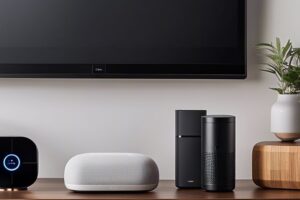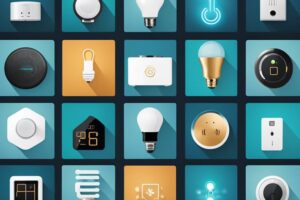If you’re looking to enhance the security and convenience of your home, integrating smart home devices with your home security system is a crucial step. By connecting your smart devices such as cameras, door locks, and sensors to your security system, you can improve the overall protection of your home and gain peace of mind. In this guide, you will learn the important steps to seamlessly integrate these devices, as well as the key benefits of doing so.
Key Takeaways:
- Research Compatibility: Before purchasing any smart home devices, it is important to ensure that they are compatible with your existing home security system. This may require consulting with a professional or researching online to find suitable options.
- Consider Integration Options: Many home security systems come with the option to integrate with various smart home devices such as cameras, smart locks, and sensors. Consider the features you want and how they can be integrated with your security system.
- Enhance Security Measures: Integrating smart home devices can enhance the overall security of your home by providing additional capabilities such as remote monitoring, notifications, and automation of security processes.
- Professional Installation: For complex integrations or systems, it may be necessary to have the smart home devices and security system professionally installed to ensure proper functionality and security measures.
- Regular Maintenance: Once integrated, it is important to regularly maintain and update both the smart home devices and security system to ensure they continue to operate effectively and provide the best possible security for your home.
Choosing the Right Smart Devices
When integrating smart home devices with your security system, it is crucial to choose the right devices that not only meet your specific security needs but also seamlessly work together to provide comprehensive protection for your home. With a wide range of smart devices available in the market, it can be overwhelming to make the right choice. Here are some key factors to consider when selecting smart devices for your home security system.
Compatibility with Existing Security Systems
When choosing smart devices for your home security system, it is essential to ensure that they are compatible with your existing security system. This will allow you to integrate the new devices seamlessly without any compatibility issues. Check whether the smart devices you are considering are designed to work with your current security system or if they require additional equipment or adaptors to function together effectively.
Essential Features for Enhanced Security
When selecting smart devices for your home security system, it’s important to look for essential features that will enhance the overall security of your home. Look for devices with advanced encryption to protect your data and privacy, motion sensors for detecting movement, night vision for improved visibility in low-light conditions, and automatic alerts that notify you of any suspicious activity in real-time. These features are crucial for bolstering the security of your home and providing you with peace of mind.
Integration Strategies
Integrating smart home devices with your home security system can greatly enhance the overall safety and convenience of your home. By connecting these two systems, you can ensure that your smart devices work in tandem with your security system to provide round-the-clock protection for your property and loved ones. To learn more about How to Integrate Smart Home Accessories with Your Security System, read on for some useful strategies.
Step-by-Step Setup Guide
When integrating smart home devices with your home security system, it’s important to follow a systematic approach to ensure a smooth and seamless setup. Here’s a step-by-step guide to help you get started:
| Step 1 | Assess Compatibility: Check whether your smart home devices are compatible with your security system. Some systems may require specific protocols or integration platforms. |
| Step 2 | Configure Settings: Adjust the settings of your smart devices and security system to enable communication and coordination between the two systems. |
| Step 3 | Test Connectivity: After configuration, test the connectivity between your smart devices and security system to ensure they are working together effectively. |
Tips for Seamless Integration
When integrating smart home devices with your security system, careful planning and attention to detail are crucial to achieving a seamless integration. Here are a few tips to help you along the way:
- Understand Compatibility: Ensure that your smart devices are compatible with your security system to avoid any connectivity issues.
- Update Firmware: Keep your smart devices and security system firmware updated to benefit from the latest features and security patches.
- Coordinate Installation: Schedule the installation and setup of your smart devices and security system to ensure they are synchronized from the start.
Any oversight in the integration process can lead to malfunctioning devices or security vulnerabilities, so it’s important to follow these tips diligently.
Maximising Your Smart Home Security
When integrating smart home devices with your home security system, it’s important to maximise the effectiveness of your setup. This means maintaining and updating your devices regularly, as well as following best practices for optimal performance.
Regular Maintenance and Updates
Regular maintenance and updates are crucial for keeping your smart home security system running smoothly. Make sure to check for firmware updates for all of your smart devices, including cameras, motion sensors, and smart locks. These updates often include bug fixes and security patches that can protect your home from vulnerabilities. Additionally, you should clean and test your devices on a regular basis to ensure they are functioning properly. This includes cleaning camera lenses, replacing batteries, and testing motion sensors and alarms.
Best Practices for Optimal Performance
There are several best practices you can follow to ensure optimal performance of your smart home security system. Firstly, make sure your Wi-Fi network is secure and has a strong password to protect against hacking attempts. You should also consider setting up a separate network specifically for your smart home devices to further enhance security. It’s also important to regularly review and update your access control list, ensuring that only authorised individuals have access to your smart home system. Finally, consider investing in professional monitoring services to improve the overall efficacy of your security system.
Troubleshooting Common Issues
Integrating smart home devices with your home security system can sometimes come with its own set of challenges. However, with the right approach, you can address common issues that may arise and ensure that your smart home security setup is running smoothly.
Connectivity Problems and Solutions
If you experience connectivity problems with your smart home devices and security system, it can compromise the overall effectiveness of your home security. This could be due to a weak Wi-Fi signal, distance from the router, or interference from other devices. To address this, consider using a Wi-Fi extender to strengthen the signal in areas where connectivity is an issue. Alternatively, you can also invest in a mesh Wi-Fi system that blankets your home with a strong, consistent signal. Additionally, placing your smart home devices strategically and away from potential interference can also help improve connectivity.
Addressing Security Vulnerabilities
One of the main concerns when integrating smart home devices with your security system is the potential security vulnerabilities that may arise. Ensuring that your devices and security system are regularly updated with the latest firmware and security patches is essential in addressing these vulnerabilities. Additionally, using strong, unique passwords for each device and enabling two-factor authentication can add an extra layer of security to your smart home setup. Regularly reviewing your system’s privacy settings and being mindful of the devices and apps you integrate into your system can help mitigate potential security risks.
To wrap up
Integrating smart home devices with your home security system is a great way to enhance the safety and convenience of your home. By following the steps outlined in this guide, you can ensure that all your smart devices work seamlessly with your security system, providing you with a comprehensive and interconnected approach to home automation and protection. To further explore the possibilities of building a smart home with integrated security, you can visit How Do I Build a Smart Home with Home Security? for more insightful information and products. Remember to always prioritise the security aspect of your smart home, and enjoy the peace of mind that comes with a well-integrated system.
FAQ
Q: What are the benefits of integrating smart home devices with your home security system?
A: Integrating smart home devices with your home security system allows you to have remote control over your security settings, receive instant alerts, and have a more comprehensive view of your home environment.
Q: What smart home devices can be integrated with a home security system?
A: Smart home devices such as smart locks, cameras, doorbells, motion sensors, and lighting systems can be integrated with a home security system to enhance its functionality.
Q: How do I integrate smart home devices with my home security system?
A: You can integrate smart home devices with your home security system by using compatible devices that have the ability to connect to your security system’s hub or control panel. This can often be done through a mobile app or a centralised platform.
Q: Are there any security considerations when integrating smart home devices with a home security system?
A: Yes, it’s important to ensure that all smart home devices are secured with strong, unique passwords and that their firmware is kept up to date to prevent potential vulnerabilities. Additionally, it’s advisable to use devices from reputable manufacturers with a focus on security.
Q: Can integrating smart home devices with a home security system save energy and reduce costs?
A: Yes, integrating smart home devices with a home security system can lead to energy savings and reduced costs by allowing you to automate lighting, heating, and cooling based on occupancy and preferences. This can lead to increased energy efficiency and lower utility bills.









